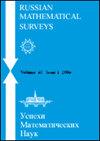Bifurcations in spatially distributed chains of two-dimensional systems of equations
IF 2.1
4区 数学
Q1 MATHEMATICS
引用次数: 4
Abstract
u̇j = Auj + F (uj) + D[uj+1− 2uj + uj−1], j = 1, . . . , N ; u0 ≡ uN , uN+1 ≡ u1. (2) We associate the element uj(t) with the value of a function u(t, xj) of two variables, where xj = 2πjN−1 is the angular coordinate. The main assumption is that the number N of elements in (2) is sufficiently large, so that the parameter ε = 2πN−1 is sufficiently small: 0 < ε ≪ 1. This gives reason to switch from the discrete system (2) to the following system, which is continuous with respect to the spatial variable x:二维方程组空间分布链中的分岔
u̇j=Auj+F(uj)+D[uj+1−2uj+uj−1],j=1,Nu0选择uN,uN+1选择u1。(2) 我们将元素uj(t)与两个变量的函数u(t,xj)的值相关联,其中xj=2πjN−1是角坐标。主要假设(2)中元素的数量N足够大,因此参数ε=2πN−1足够小:0<ε≪1。这给出了从离散系统(2)切换到以下系统的理由,该系统相对于空间变量x是连续的:
本文章由计算机程序翻译,如有差异,请以英文原文为准。
求助全文
约1分钟内获得全文
求助全文
来源期刊
CiteScore
1.70
自引率
0.00%
发文量
12
审稿时长
>12 weeks
期刊介绍:
Russian Mathematical Surveys is a high-prestige journal covering a wide area of mathematics. The Russian original is rigorously refereed in Russia and the translations are carefully scrutinised and edited by the London Mathematical Society. The survey articles on current trends in mathematics are generally written by leading experts in the field at the request of the Editorial Board.

 求助内容:
求助内容: 应助结果提醒方式:
应助结果提醒方式:


